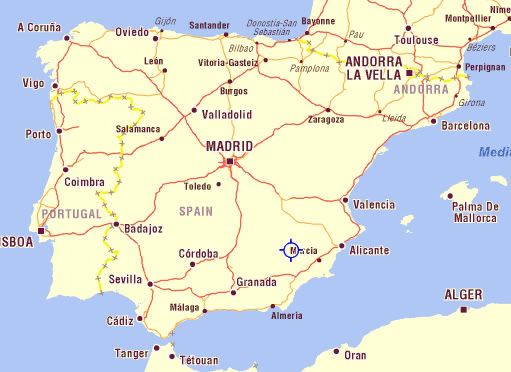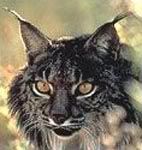Post by Carlos on Mar 24, 2006 17:18:41 GMT
I'm offering to the forum the translation of the Canis lupus deitanus account made by its author, Angel Cabrera. Just remember that Cabrera was not a "quick describer" as one could think. He was a very serius scientist who described many mammal taxa that are still valid today.
A very strange mist surrounds this subspecies. The Type (and only known) locality is Moratalla:

The material Cabrera used to describe it were just two individuals from that mediterranean mountain range in the Spanish dry South West, a place were the subspecies most likely was already on the brink of extinction by the time of its description.
By the way it shoud be called Spanish Levantine Wolf, to avoid confussion with the Iberian Wolf (C. l. signatus)
I'm also wondering if those captive wolves were ever preserved at the Museum of Natural Sciences in Madrid, after this book was published. It would be worth to check it.
The translation:
Cabrera, A. (1914): Fauna Ibérica. Mamiferos. Museo Nacional de Ciencias Naturales. Madrid.
p. 183
Canis lupus deitanus Cabrera
Canis lupus deitanus Cabrera, Bol. Real Soc. Españ. Hist. Nat., VII(1907), pg 197, lam. III.
Diagnosis. - Very much smaller than C. l. signatus and with the belly buff instead of whitish.
Characteristics.- General appearance like the previous subspecies [C. l. signatus] but more lightly build, recalling the jackal. The colour similar to signatus, but the cheeks, although showing many white hairs don’t show a defined stripe and the belly is buff ochre becoming yellowish white around the genitals. The upper parts show the same buff colour mixed with black, forelegs bright ochre buff and inner part of the legs pale buff. The nape is dark sorrel; muzzle of the same colour, somewhat paler; throat and lower neck, off white. Tail buff suffused with grey, shadowed with black on top and tip; upper third of its inner part whitish. The characteristic black stripe in the wrists is badly marked.
As I have only studied this subspecies from live individuals, I haven’t been able to check skull and teeth characteristics, nor taken exact measurements. The shoulder height of the type is about 580 mm; C. l. signatus height is between 680 and 720 mm.
Range.- Mountains of the “orospedano” district in Murcia. Type locality Moratalla.
The only specimens of this wolf subspecies that I’ve ever seen are those that I based my description on, a male and a female living at Madrid Zoo since seven years ago. All my efforts to get specimens (skins and skulls) from the same locality or nearby areas have been fruitless so far, wich is an inconvenience since descriptions made from living specimens are always incomplete and can leave room for doubt. In this case, though, it seems evident to me that those small wolves with reddish belly and jackaloid appearance should be considered as a different form from the one living in the north, centre and west of the Peninsula, which is very hefty and has whitish belly.
Canis lupus deitanus is probably the wolf of all mountain ranges parallel to the Mediterranean coast, but so far I lack the evidence to establish the true limits of its range.
A very strange mist surrounds this subspecies. The Type (and only known) locality is Moratalla:

The material Cabrera used to describe it were just two individuals from that mediterranean mountain range in the Spanish dry South West, a place were the subspecies most likely was already on the brink of extinction by the time of its description.
By the way it shoud be called Spanish Levantine Wolf, to avoid confussion with the Iberian Wolf (C. l. signatus)
I'm also wondering if those captive wolves were ever preserved at the Museum of Natural Sciences in Madrid, after this book was published. It would be worth to check it.
The translation:
Cabrera, A. (1914): Fauna Ibérica. Mamiferos. Museo Nacional de Ciencias Naturales. Madrid.
p. 183
Canis lupus deitanus Cabrera
Canis lupus deitanus Cabrera, Bol. Real Soc. Españ. Hist. Nat., VII(1907), pg 197, lam. III.
Diagnosis. - Very much smaller than C. l. signatus and with the belly buff instead of whitish.
Characteristics.- General appearance like the previous subspecies [C. l. signatus] but more lightly build, recalling the jackal. The colour similar to signatus, but the cheeks, although showing many white hairs don’t show a defined stripe and the belly is buff ochre becoming yellowish white around the genitals. The upper parts show the same buff colour mixed with black, forelegs bright ochre buff and inner part of the legs pale buff. The nape is dark sorrel; muzzle of the same colour, somewhat paler; throat and lower neck, off white. Tail buff suffused with grey, shadowed with black on top and tip; upper third of its inner part whitish. The characteristic black stripe in the wrists is badly marked.
As I have only studied this subspecies from live individuals, I haven’t been able to check skull and teeth characteristics, nor taken exact measurements. The shoulder height of the type is about 580 mm; C. l. signatus height is between 680 and 720 mm.
Range.- Mountains of the “orospedano” district in Murcia. Type locality Moratalla.
The only specimens of this wolf subspecies that I’ve ever seen are those that I based my description on, a male and a female living at Madrid Zoo since seven years ago. All my efforts to get specimens (skins and skulls) from the same locality or nearby areas have been fruitless so far, wich is an inconvenience since descriptions made from living specimens are always incomplete and can leave room for doubt. In this case, though, it seems evident to me that those small wolves with reddish belly and jackaloid appearance should be considered as a different form from the one living in the north, centre and west of the Peninsula, which is very hefty and has whitish belly.
Canis lupus deitanus is probably the wolf of all mountain ranges parallel to the Mediterranean coast, but so far I lack the evidence to establish the true limits of its range.




